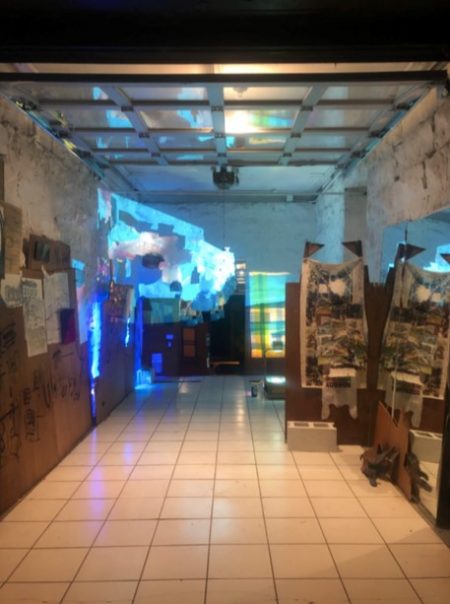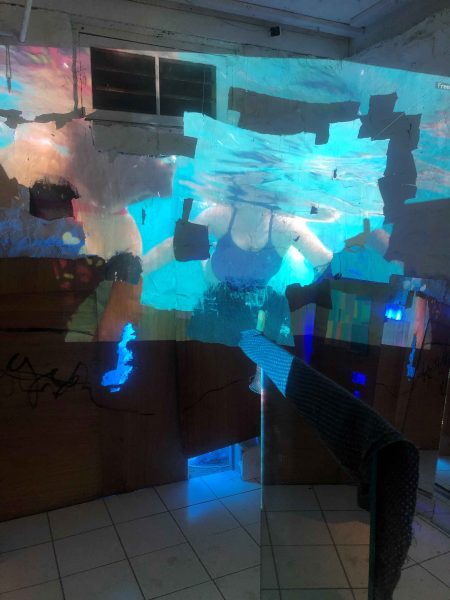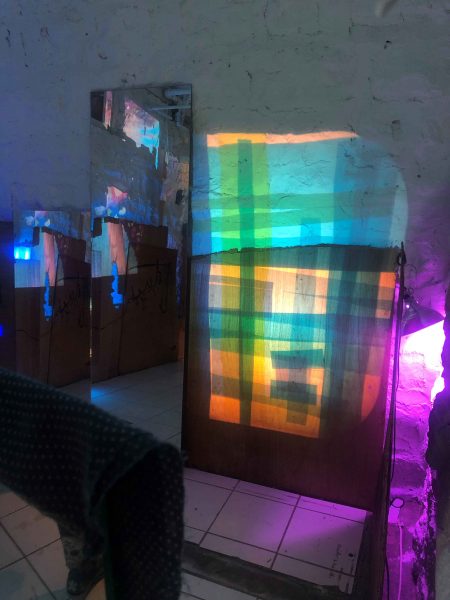
In mid February I had read Alex Greenberger’s overview of several New York Museum exhibitions that all mirrored the strained sensation that is overwhelmingly pervasive at the moment.[1] In it, Greenberger covers Rachel Harrison’s mid-career survey, Life Hack, at the Whitney and makes the observation that Harrison taps into our contemporary media overload:
. . . too many ideas circulating all around us make it impossible to home in on any one of them. Art . . . has the ability to suck it all in and spit it back out at the viewer in novel ways. It might not make sense, but it will open up new ways of understanding.[2]
It was on Saturday, March 7th, 2020 that I attended the opening reception for Cat Mummies Came First; where gallerist of Sheherandeze, Julie Leidner, and the exhibiting artist Kim Charles Kay, had already begun taking the necessary precautions for COVID-19 and self-quarantine culture: hosting a large sign over shared food areas encouraging tongs and all at present to employ a “elbow-shake” policy, abundantly shared smiles, and alcohol wipes at all interactive spots in the exhibition. No one knew that this was going to be one of the last interactions before a forced practice in monastic isolation.

Upon street entry on the night of the opening reception (the only time Sheherandeze’s gallery is physically open, the rest of the time its glass garage door remains closed so that the exhibition is contained but exposed like a capsule) the space reads as a drawing. The installation holds the capacity for light, form, holes, pattern, line, and chiaroscuro to merge into an omnipresent icon for memory. It’s difficult to account for a chronological account of the objects that appear as you enter the installation due to the utilization of multiple projections, mirrors, and other reflective apparatus that project one spatial experience onto another. According to the statement, the installation is made from “light, video, driftwood (from Lake Michigan and the Ohio River / rubbed wood by two water bodies), dinosaur blood (plastic), pieces of found and handmade quilts, found and family images, and drawings on paper.” The “driftwood” the author references is not branch driftwood; but rather pre-manufactured planks of chipboard that have been disenfranchised from their industrial use and left as refuse alongside riverbeds in industrial regions. It is thus indicative of both the hands that constructed it and the earth that birthed it. On this driftwood Kay has made gestural, quasi-abstracted marks with charcoal and then attached or collaged numerous drawings. These drawings, made from rubbing pencil over the facades of various gravestones around Kay’s Kalamazoo home cultivate a connection between the artists’ action and the preservation of the life of another. Further collaged onto this driftwood architecture within the installation are several parts of a quilt circa 1840 that has been “deconstructed to reveal the effect of time in its surface colors.” The quilt becomes the debris of use that is indicative of well worn affection in the form of warmth or security that a blanket brings. This affection is made visible by the collection of skin cells and the fading of dye. These little quilt scraps become, yet another, exemplified connection between the humanity of now, and humanity that has been. To return to the driftwood in order to continue through the remainder of the installation: this driftwood contains holes, uneven edges, and signs of wear that allow for the light from a projection of a body swimming in water to pass through— the very support construction of the exhibition feels like a materially literal presentation of the passage of time or the multiplicity of experience.
Towards the back of the gallery is a large quilt, this time made by the artist, that has been covered in gesso and used as a projection screen. The screen, maintaining its quiltedness on the back, becomes a metaphorical object for psychological projection, displaying the video of an experience of the artist. This video shows a body drifting effortlessly above the perspective of the camera and occasionally kicking and cultivating small air bubbles. The somewhat abstract video work offers endless potential for meaning and value depending on the viewers’ experience with water—its generality allows for specific projection of the viewer—this image could easily appear to indicate leisure or a body slowly beginning to struggle with the water they find themselves in—this narrative could change depending on the viewers’ relationship with water.

Along the back wall are a collection of objects that work to continue the language of drawing as a metaphor—as the visual ‘ground’ of the installation. Along with more driftwood propped up against the wall, towards the right, seated on the floor is a small transparency projector with strips of colored transparency film, the film being projected onto the wall. The image projected appears like a playful or haphazard Josef Albers composition. It matches stylistically similar in pattern to a small collage staged to the left on a piece of drift plywood: strips of yellow, green, and blue layer and cross to immolate the quilts found at the front of the installation from 1840. Also resting on the back wall, in between the yellow, green, and blue layered compositions, rests a large mirror. Its position within the gallery allows it to reflect the viewer back at themselves but also whatever is behind them—creating a pluralistic experience of time—a blurring of the visual causal nature of that which is front of you, that which is behind you, and momentarily phenomenological experience.
In addition to being an artist and ritualist, Kim Charles Kay is an ancestral healing practitioner. Ancestral healing, which I knew nothing about prior to this exhibition, is the “practice of bringing people into a closer, healthier relationship with their recent and ancient ancestors of blood—a vocation of allyship.” This is an insightful and intriguing approach to interaction with shared humanoid history, especially when examined through the lens of Paul Ricœur’s writings. As a French philosopher practicing in hermeneutic phenomenology, Ricœur placed individual death within two categories: biological death and social or narrative death. Biological death, of course, defined as the “final event” or the entering into of an “absolute state” of being dead and is synonymous with the medical definition of death. Narrative or social death (the terms are interchangeable), which is much more applicable with regard to Kay’s work, is a relational or narrative change in the meaning of a human life. It involves a change in the narrative identity of persons that either still exist or have once existed.[1] Beyond one’s physical death, narrative death happens when a person’s name is uttered for the last time. The term was made popular by Banksy and a handful of pseudo-philosophers in the mid 2000s. In their coinage, our second ‘death’ occurs after we are officially forgotten. Kay’s artistic practice, in turn, serves to extend identities of the narratively deceased subjects of her work. She serves as an administer, lessening that action of forgetting by cultivating a spiritual transitive memory for her audience and their past relatives. Ricœur also reminds us that there are actually two Latin root terms for “identity,” which in turn references the terms’ duality. “Identity” understood as ‘being the same’ (idem), is usually interpreted as the question ‘what am I?’ ‘Self-constancy’ (ipse), however, is understood in the question ‘who am I?’
It is the experience of both idioms of ‘identity’ then that pulls at the past and future sense of community—as our “what am I?” and our “who am I” both consist of peripheral experience associated with memory, place, history, and a sense of self-actualized hope for the future. Who we are is typically everything that came prior and everything we wish to be. What we are constitutes all of the happenings within our bodies and within our histories, both personal and historic.
Cat Mummies Came First grants observation of a lived experience as a juxtaposed historical and contemporaneous moment—one with remarkable affection for those of the present, past, and future. This feels like a prize or gift in this world that has changed with effervescence over-night. And reads like a well manufactured drawing, pulling the composition from a multitude of planes that all interact with cohesion and clarity—in a world where that isn’t always probable.
At a time that feels historic, overbearing, and bound with limitless possibilities, Kay’s installation becomes a place to consider our bodies in drawing and our spirits, simultaneously, in times of historic peril and hopeful post-capitalistic futures.
Cat Mummies Came First will be installed within the window gallery of Sheherazade on Magnolia Street in between the 2nd and 3rd block until May 3rd, 2020.
–Megan Bickel
[1] Greenberger, Alex. “With Unrest Escalating Around the World, New York’s Museum Shows Reflect a Tense Mood.” Artnews. February 18th, 2020.
[2] Greenberger, Alex.
[3] Ricoeur, Paul. (1992). Oneself as Another trans. Blamey, K. Chicago and London: University of Chicago Press.